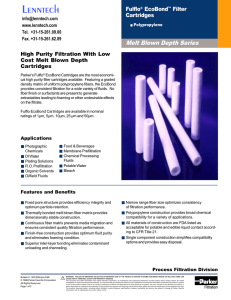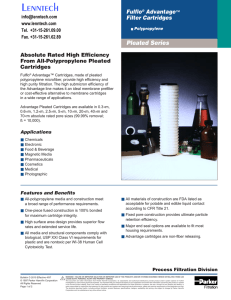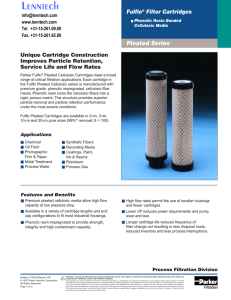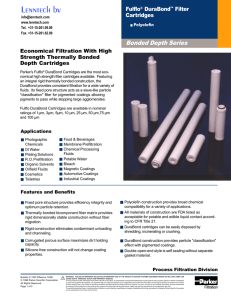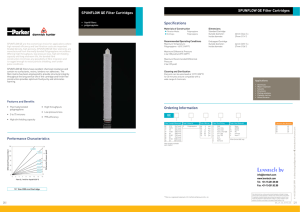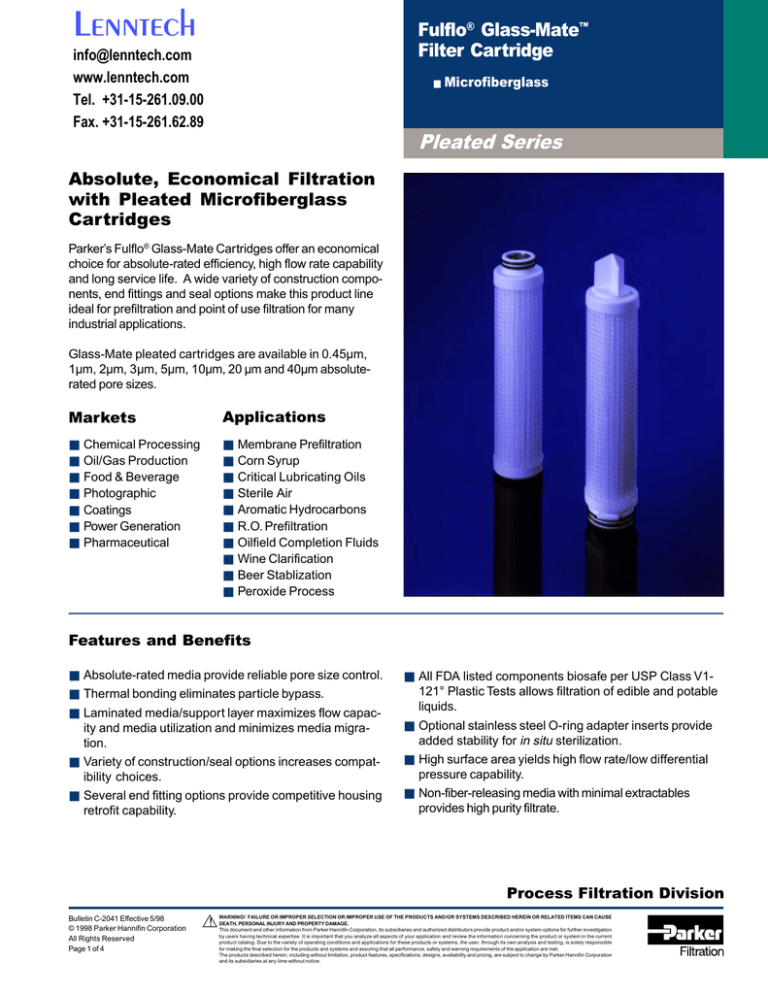
Lenntech
Fulflo® Glass-Mate
Filter Cartridge
info@lenntech.com
www.lenntech.com
Tel. +31-15-261.09.00
Fax. +31-15-261.62.89
■
Microfiberglass
Pleated Series
Absolute, Economical Filtration
with Pleated Microfiberglass
Cartridges
Parker’s Fulflo® Glass-Mate Cartridges offer an economical
choice for absolute-rated efficiency, high flow rate capability
and long service life. A wide variety of construction components, end fittings and seal options make this product line
ideal for prefiltration and point of use filtration for many
industrial applications.
Glass-Mate pleated cartridges are available in 0.45µm,
1µm, 2µm, 3µm, 5µm, 10µm, 20 µm and 40µm absoluterated pore sizes.
Markets
Applications
■
■
■
■
■
■
■
■
■
■
■
■
■
■
■
■
■
Chemical Processing
Oil/Gas Production
Food & Beverage
Photographic
Coatings
Power Generation
Pharmaceutical
Membrane Prefiltration
Corn Syrup
Critical Lubricating Oils
Sterile Air
Aromatic Hydrocarbons
R.O. Prefiltration
Oilfield Completion Fluids
Wine Clarification
Beer Stablization
Peroxide Process
Features and Benefits
■ Absolute-rated media provide reliable pore size control.
■ Thermal bonding eliminates particle bypass.
■ Laminated media/support layer maximizes flow capacity and media utilization and minimizes media migration.
■ Variety of construction/seal options increases compatibility choices.
■ Several end fitting options provide competitive housing
retrofit capability.
■ All FDA listed components biosafe per USP Class V1121° Plastic Tests allows filtration of edible and potable
liquids.
■ Optional stainless steel O-ring adapter inserts provide
added stability for in situ sterilization.
■ High surface area yields high flow rate/low differential
pressure capability.
■ Non-fiber-releasing media with minimal extractables
provides high purity filtrate.
Process Filtration Division
Bulletin C-2041 Effective 5/98
© 1998 Parker Hannifin Corporation
All Rights Reserved
Page 1 of 4
!
WARNING! FAILURE OR IMPROPER SELECTION OR IMPROPER USE OF THE PRODUCTS AND/OR SYSTEMS DESCRIBED HEREIN OR RELATED ITEMS CAN CAUSE
DEATH, PERSONAL INJURY AND PROPERTY DAMAGE.
This document and other information from Parker Hannifin Corporation, its subsidiaries and authorized distributors provide product and/or system options for further investigation
by users having technical expertise. It is important that you analyze all aspects of your application and review the information concerning the product or system in the current
product catalog. Due to the variety of operating conditions and applications for these products or systems, the user, through its own analysis and testing, is solely responsible
for making the final selection for the products and systems and assuring that all performance, safety and warning requirements of the application are met.
The products described herein, including without limitation, product features, specifications, designs, availability and pricing, are subject to change by Parker Hannifin Corporation
and its subsidiaries at any time without notice.
Pleated Series
Technology
Construction
The high surface area and high void
volume matrix provided by pleated
microfiberglass media optimize flow
rate and service life capability
unattainable with any other
microfiber technology. The hydrophilic nature of the microglass
medium also enhances flow rate
capability. The microfiber matrix
lends itself well to optimizing the
pore size geometry necessary to
provide absolute-rated filtration
performance. A polyester laminated
support layer maintains pore size
consistency of the microglass
medium, improves flow through the
pleat configuration and eliminates
fiber migration. Acrylic binder in the
microglass medium also contributes
significantly to media migration
control.
Four distinct support constructions
are available to maximize chemical
compatibility and application requirements. All available construction
types are generally satisfactory for
water and water-based solutions,
organic solvents and inorganic
chemicals in a pH range of 5-10.
General application areas include
plating chemicals, syrups, alcoholic
beverages, polymers, lubricating
oils, brines, emulsions, process air
and magnetic media.
1. Polypropylene Heavy-Duty ("F"
Code): this special construction
features standard polypropylene end
capping, but has a glass-filled
polypropylene core and pure
polypropylene extruded outer cage.
This construction withstands
temperatures up to 200°F @ 35 ∆P.
In addition backwashing may be
accomplished to enhance service life
or to perform in situ sanitization or
sterilization required by many
beverage applications. Hot water
may also be used to dissolve
proteins and carbohydrates collected
during beverage filtration.
2. Polyester ("P" Code): core, end caps
and outer netting of polyester are
required for the filtration of specific
aggressive fluids not generally
compatible with polypropylene
components. These fluids include
halogenated and aromatic organic
solvents and mineral oil based
lubricants. One primary application
is the filtration of the benzene-based
organic used in the peroxide manu
facturing process. The maximum
recommended temperature for this
construction is 140°F @ 35 ∆P.
3. Stainless Steel ("G" Code): stainless steel components allow usage
of the cartridge up to 275°F @ 35 ∆P.
Microglass media is non-protein
binding, i.e. it doesn't remove flavor
enhancing proteins from beer, wine
and similar beverages. Glass-Mate
cartridges can be used as final
filters to clarify red wines and other
beverages which are not normally
sterile filtered. In addition the
medium has the unique ability to
remove high molecular weight
carbohydrates, such as β-glucans,
from these same beverages.
β-Glucans are gel forming materials
which tend to plug microporous
membranes used in the stabilization
(sterile filtration) of beverages.
When used as pre-filters, GlassMate cartridges will significantly
increase the throughput of expensive membrane final filters.
Bulletin C-2041
Page 2 of 4
36
An outer netting of polyester is used
with this style cartridge.
4. Stainless Steel Insert ("S" Code): a
stainless steel insert can be installed
into the I.D. of the 222 or 226 O-ring
adapter to enhance the in situ
sterilization capability of the GlassMate cartridge. The insert prevents
distortion to the O-ring adapter due to
the cyclic hot and cold temperatures
associated with steam sterilization,
autoclaving and similar processes.
Stainless Steel Inserts
Efficiency, flow capability and
service life are similar for all available constructions.
Performance
The Glass-Mate product line offers
absolute-rated efficiency performance as determined by the ASTM
F795-88 Filter Test Method. Published absolute particle removal
ratings were established at 99.98%
(βx=5000) efficiency at 2.5 gpm
design flow rate.
Pleat configuration was optimized to
maximize dirt holding capacity and
flow rate capability. The clean
pressure drop for all ratings is less
than 0.8 psi at maximum recommended flow rate of 7.0 gpm.
Due to the variability of processes,
testing is recommended to optimize
the final filter element selection.
Pleated Series
■ Performance Profile
Glass-Mate Particle Removal Efficiency Over Life
■ Flow Rate Capability:
Glass-Mate
Length Factors
Length
Length
(in)
Factor
9
10
19
20
29
30
39
40
1.0
1.0
2.0
2.0
3.0
3.0
4,0
4.0
Glass-Mate Cartridge
Flow Factors
(psid/gpm @ 1 cks)
Rating
(µm)
A = PMG004
D = PMG030
G = PMG200
B = PMG010
E = PMG050
H = PMG400
C = PMG020
F = PMG100
0.45
1
2
3
5
10
20
40
Cartridge
PMG004
PMG010
PMG020
PMG030
PMG050
PMG100
PMG200
PMG400
0.45
1.0
2.0
3.0
5
10
20
40
Beta Ratio (β) =
ß = 1000
99.9%
0.3
0.6
1.2
1.8
3
7
16
32
.108
.102
.095
.090
.072
.060
.042
.018
Flow Rate and Pressure Drop Formulas:
■ Liquid Particle Retention Ratings (µm)@ Removal Efficiency of:
ß = 5000
Absolute
Flow
Factor
ß = 100
99%
<0.1
0.2
0.4
0.7
1.3
3
8
20
ß = 20
95%
ß = 10
90%
<0.1
<0.1
0.2
0.3
0.5
1.6
4
11
<0.1
<0.1
0.1
0.2
0.4
1.2
2.5
8
Flow Rate (gpm) = Clean ∆P x Length Factor
Viscosity x Flow Factor
Clean ∆P = Flow Rate x Viscosity x Flow Factor
Length Factor
Notes:
1. Clean ∆P is PSI differential at start.
2. Viscosity is centistokes.
Use Conversion Tables for other units.
3. Flow Factor is ∆P/GPM at 1 cks for 10 in (or single).
4. Length Factors convert flow or ∆P from 10 in
(single length) to required cartridge length.
Upstream Particle Count @ Specified Particle Size and Larger
Downstream Particle Count @ Specified Particle Size and Larger
[ ]
β - 1 x 100
β
Performance determined per ASTM /F-795-88. Single-Pass Test using
AC Test Dust in water at a flow rate of 2.5 gpm per 10 in cartridge (9.5
lpm per 254 mm).
% Removal Efficiency =
Bulletin C-2041
Page 3 of 4
37
Pleated Series
Specifications
Absolute Filtration Ratings:
■ 99.98% (Bx=5000) removal efficiency at
0.45µm, 1µm, 2µm, 3µm, 5µm, 10µm,
20µm and 40µm pore sizes
Effective Filtration Area:
■ 5 ft2/10 in (0.46 m2/254 mm) minimum
Materials of Construction:
■ Filter Medium: Borosilicate
microfiberglass with acrylic binder
■ Support/Drainage Layers: Spunbonded polyester; laminated on the
downstream side
■ Polypropylene Support ("F" Code):
Glass-filled polypropylene core;
polypropylene end caps and outer
extruded cage; sonic welded side seal;
melt bonded end caps
■ Polyester Support ("P" Code):
Polyester core, end caps and outer
netting; sonic welded side seal; FDA
grade white urethane-adhered end caps
■ Stainless Steel ("G" Code): 304 SS
core and end caps; polyester outer
netting; sonic welded side seal; FDA
grade white urethane-adhered end caps
■ O-Ring Adapter Insert: 316 stainless
steel
■ Seal Materials:
- Polyethylene foam: standard gasket
for DOE polypropylene supported
cartridge
- Viton: standard gasket for DOE
polyester or stainless steel supported
cartridges
- See nomenclature for other gasket
and O-ring options
Recommended Operating Conditions:
■ Changeout Differential Pressure: 35
psi (2.4 bar)
■ Maximum Flow Rate: 7 gpm per
10 in length (26.5 lpm/254 mm)
■ Design Flow Rate: 2.5 gpm per 10
in length (9.5 lpm/254mm)
■ Maximum Temperature:
- Glass-Filled Polypropylene:
200°F @ 35∆P (93°C/2.4 bar)
- Polyester:
140°F @ 35∆P (60°C/2.4 bar)
- Stainless Steel:
275°F @ 35∆P (135°C/2.4 bar)
■ Maximum Differential Pressure:
- Glass-Filled Polypropylene:
90 psi @ 75°F (6.2bar/24°C)
- Polyester:
70 psi @ 75°F (4.8 bar/24°C)
- Stainless Steel:
75 psi @ 275°F (5.1 bar/135°C)
Cartridge Dimensions:
■ Lengths: Various. See Ordering
Information and catalog sheet C-2090
■ Outside Diameter: 2.5 in (63.5 mm)
■ Inside Diameter:
DOE - 1-1/16 in (27 mm)
SOE - 1 in (25.4 mm)
Biological Safety/Product Purity:
■ Meets USP XXI Class VI requirements
for plastics
■ All components FDA listed per CFR,
Title 21
■ Non-fiber releasing per FDA
Part 210.3B (5) and (6)
■ Non-photo sensitive
Sterilization/Sanitization:
■ Hot water ("F" construction): 180°F
(82°C) for 30 minutes at maximum 15
psid (1 bar).
■ In-Line Steam/Autoclave ("F" construction with stainless steel sleeve): 60
minutes at 255°F (140°C) at 2 psid
(0.14 bar) maximum pressure.
Ordering Information
PMG
100
10
F
N
STC
Cartridge Code
Absolute
Particle
Removal
Rating
(µm)
Nominal
Length
Support Construction
Gasket/O-Ring
Options
End Cap Options
A = Polyethylene Foam
(DOE gasket only)
E = EPDM
N = Buna-N
S = Silicone
(SOE O-ring Only)
T = Teflon Encapsulated
Viton (222, 226
O-ring Only)**
V = Viton**
DO
Pleated
Micro
Glass
004 = 0.45
010 = 1.0
020 = 2.0
030 = 3.0
050 = 5.0
100 = 10.0
200 = 20.0
400 = 40.0
Code in
9
10
19
20
29
30
39
40
mm
9-5/8
244
9-13/16
249
19-5/8
498
19-15/16 506
29-1/4
743
30-1/16
764
39
991
40
1016
F = Glass-Filled
Polypropylene
(Core Only)
G = 304 Stainless
Steel
P = Polyester
AR
DX
LL
LR
PR
SC
SF
TC
TF
SSC
SSF
STC
Example: PMG100-10FN-STC
STF
* Two "020" O-rings are packed with each cartridge. Replace those in the housing with every cartridge change.
** Trademark of E.I. duPont Nemours & Co.
= 020 O-Ring/
Recessed*
= Double Open End
(DOE)
= DOE with Core
Extender
= 120 O-Ring (Both Ends)
= 120 O-Ring/Recessed
= 213 O-Ring/Recessed
= 226 O-Ring/Closed
= 226 O-Ring/Fin
= 222 O-Ring/Closed
= 222 O-Ring/Fin
= S.S. Inserted 226
O-Ring/Closed
= S.S. Inserted 226
O-Ring/Fin
= S.S. Inserted 222
O-Ring/Closed
= S.S. Inserted 222
O-Ring/Fin
Lenntech
Bulletin C-2041
Page 4 of 4
info@lenntech.com
www.lenntech.com
Tel. +31-15-261.09.00
Fax. +31-15-261.62.89

